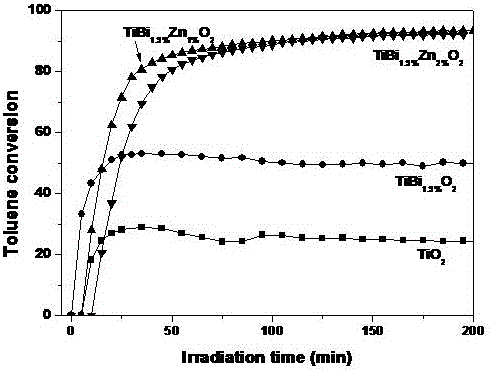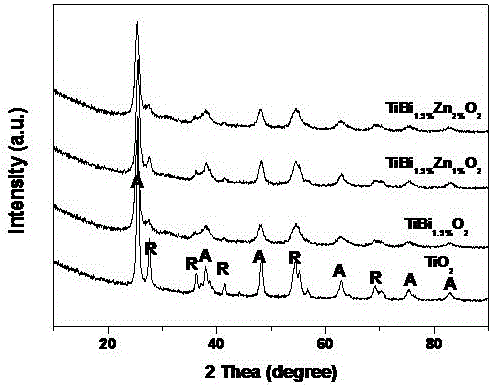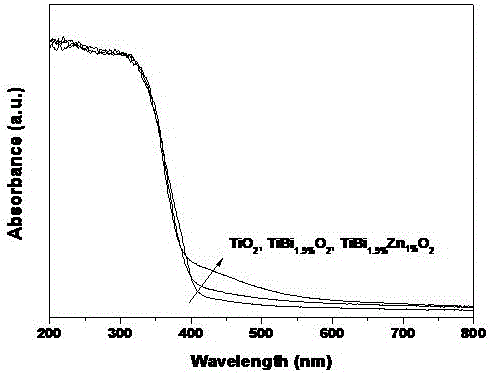Bismuth and zinc doped titanium dioxide photocatalyst and preparation method and application thereof
A technology of titanium dioxide and photocatalyst, which is applied in the field of bismuth-zinc-doped titanium dioxide photocatalyst and its preparation, which can solve the problems of low utilization rate of solar energy and achieve the effects of enhanced visible light absorption, good catalytic activity and increased probability
- Summary
- Abstract
- Description
- Claims
- Application Information
AI Technical Summary
Problems solved by technology
Method used
Image
Examples
Embodiment 1
[0015] Weigh 40.80g of titanyl sulfate, 2.33g of bismuth nitrate and 0.75g of zinc nitrate and dissolve in 582mL of absolute ethanol, and stir at room temperature. Add 290ml of glycerol and 285ml of anhydrous diethyl ether gradually under stirring, stir for 1 hour until the mixture is uniform, then transfer to the synthesis kettle, seal the kettle body, solvoheat at 110°C for 48 hours, filter, and wash with absolute ethanol for 5-6 times , dried at 100°C for 6 hours, and calcined at 500°C for 4 hours in a muffle furnace to obtain the catalyst. The obtained doped photocatalyst contains 1.9% Bi and 1% Zn in terms of moles of titanium dioxide, and the obtained catalyst is marked as TiBi 1.9% Zn 1% o 2 .
Embodiment 2
[0017] In Example 1, the zinc nitrate is changed to 1.50g, and the amount of bismuth nitrate is still 2.33g, i.e. the cost example, marked as TiBi 1.9% Zn 2% o 2 .
Embodiment 3
[0019] In Example 1, the zinc nitrate is changed to 0.00g, and the amount of bismuth nitrate is still 2.33g, i.e. the cost example, marked as TiBi 1.9% o 2 .
PUM
 Login to View More
Login to View More Abstract
Description
Claims
Application Information
 Login to View More
Login to View More - R&D
- Intellectual Property
- Life Sciences
- Materials
- Tech Scout
- Unparalleled Data Quality
- Higher Quality Content
- 60% Fewer Hallucinations
Browse by: Latest US Patents, China's latest patents, Technical Efficacy Thesaurus, Application Domain, Technology Topic, Popular Technical Reports.
© 2025 PatSnap. All rights reserved.Legal|Privacy policy|Modern Slavery Act Transparency Statement|Sitemap|About US| Contact US: help@patsnap.com



